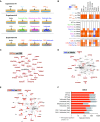Airway Microbiota Is Associated with Upregulation of the PI3K Pathway in Lung Cancer
- PMID: 29864375
- PMCID: PMC6221574
- DOI: 10.1164/rccm.201710-2118OC
Airway Microbiota Is Associated with Upregulation of the PI3K Pathway in Lung Cancer
Abstract
Rationale: In lung cancer, upregulation of the PI3K (phosphoinositide 3-kinase) pathway is an early event that contributes to cell proliferation, survival, and tissue invasion. Upregulation of this pathway was recently described as associated with enrichment of the lower airways with bacteria identified as oral commensals.
Objectives: We hypothesize that host-microbe interactions in the lower airways of subjects with lung cancer affect known cancer pathways.
Methods: Airway brushings were collected prospectively from subjects with lung nodules at time of diagnostic bronchoscopy, including 39 subjects with final lung cancer diagnoses and 36 subjects with noncancer diagnoses. In addition, samples from 10 healthy control subjects were included. 16S ribosomal RNA gene amplicon sequencing and paired transcriptome sequencing were performed on all airway samples. In addition, an in vitro model with airway epithelial cells exposed to bacteria/bacterial products was performed.
Measurements and main results: The composition of the lower airway transcriptome in the patients with cancer was significantly different from the control subjects, which included up-regulation of ERK (extracellular signal-regulated kinase) and PI3K signaling pathways. The lower airways of patients with lung cancer were enriched for oral taxa (Streptococcus and Veillonella), which was associated with up-regulation of the ERK and PI3K signaling pathways. In vitro exposure of airway epithelial cells to Veillonella, Prevotella, and Streptococcus led to upregulation of these same signaling pathways.
Conclusions: The data presented here show that several transcriptomic signatures previously identified as relevant to lung cancer pathogenesis are associated with enrichment of the lower airway microbiota with oral commensals.
Keywords: bronchoscopy; lung cancer; microbiome.
Figures




Comment in
-
Exploring Host-Microbe Interactions in Lung Cancer.Am J Respir Crit Care Med. 2018 Nov 1;198(9):1116-1118. doi: 10.1164/rccm.201807-1225ED. Am J Respir Crit Care Med. 2018. PMID: 30063838 No abstract available.
References
Publication types
MeSH terms
Substances
Grants and funding
LinkOut - more resources
Full Text Sources
Other Literature Sources
Medical
Molecular Biology Databases
Miscellaneous

